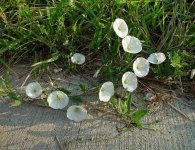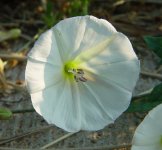Convolvulus field - convolvulus arvensis l.
Family Convolvulus - Convolvuluceae
Botanical characteristics. Curly perennial herbaceous plant. It grows in the fields, in the gardens, in the kitchen gardens, along the roadsides and embankments.
The root system is powerful. Stem curly, glabrous, up to 3 m in length or more. Leaves are alternate, petiolate, arrow-shaped, blunt-pointed. Flowers are pink or white. Fruit is a double-sided spherical capsule. Seeds are slightly triturated, grayish brown. Blooms in July - September, fructifies until late autumn.
Used parts of the plant. Medicinal raw materials are the roots, the aerial part, leaves, flowers, seeds collected in the usual way.
The roots, the aerial part, the seeds contain saponins triterpene, alkaloids, tannins, phenolcarbonic acids, coumarins, flavonoids, carbohydrates. In leaves and flowers - vitamins.
Application. In folk medicine, convolvulus is used for a long time in the form of broths and infusions of leaves and flowers in female diseases, especially after childbirth, with viscetoses, metrorrhagia, whites, with chronic bronchitis, ascites, tracheitis, acute respiratory infections; Externally - for the treatment of dermatitis, dermatomycosis, abscesses, ulcers.
In Central Asia, the juice of plants is used as a choleretic, with headache, diseases of the ear, spleen, lungs, liver, bronchial asthma, gynecology, as an antitumor, in arthritis, as a detoxification agent for bites of venomous snakes and insects, for the treatment of long-term non-healing wounds And ulcers, as cosmetic for the removal of freckles and pigment spots; In the form of powders - with wet wounds and ulcers.
In Bulgaria, convolvulus is included in the fees used for hepatitis, cholecystitis, cholelithiasis, liver cirrhosis, as a diuretic.
In the experiment, aqueous and alcohol extractions of the aerial part of the plant have anticonvulsant, antispasmodic, hypotensive, myotropic, diuretic action; Increase the rate of coronary blood flow, normalize blood pressure, accelerate blood clotting, have antitumor activity, inhibit the growth of sarcoma, exhibit antibiotic, protolytic, acoricidal activity.
The juice of a flowering plant has anesthetic, bactericidal, hemostatic, anti-inflammatory, wound-healing effect.
In Tibetan medicine, the aerial part of the plant, leaves and flowers are used for atherosclerosis, tuberculosis, syphilis, as a sedative in neuroses, fever.
In Mongolian and Indian medicine make broths of corn rootweed in eye diseases, as a laxative, with enuresis, dermatitis, astralgia.
In Korea, the decoction of seeds is used as a diuretic, anthelmintic, laxative, with edema of various etiologies, nephritis, cough, with cardiac and renal insufficiency.
Among the peoples of Western Europe, the roots of bindweed are used for gastritis, enterocolitis, gastric diseases, toothache, with fainting, and flu.
Preparation
- To prepare the infusion take 6 g of leaves or flowers, pour 200 ml of boiling water, insist on a water bath for 15 minutes, cool for 45 minutes, filter, bring to the correct amount of water. Take 1 tbsp. Spoon 3 times a day after meals.
- For broth 5 g of roots or seeds, pour 180 ml of boiling water, insist on a boiling water bath for 30 minutes, cool for 10 minutes, filter. Take should be 1 tbsp. Spoon 3-4 times a day after meals.
Contraindications. In the literature there is information about the virulence of plants, especially for horses. In this regard, the preparation of preparations from bindweed at home requires caution.
Attention! Do not exceed dosage, do not store raw materials together with other plants, hide from children.




Comments
When commenting on, remember that the content and tone of your message can hurt the feelings of real people, show respect and tolerance to your interlocutors even if you do not share their opinion, your behavior in the conditions of freedom of expression and anonymity provided by the Internet, changes Not only virtual, but also the real world. All comments are hidden from the index, spam is controlled.